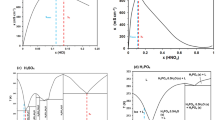Abstract
IN the measurements of Maclnnes and Shedlovsky1 and Jeffery and Vogel2 on the conductivity of acetic acid and its salts in water, which have recently been the subject of correspondence in these columns3, the most noticeable divergence is in the values for dilute solutions of sodium acetate. Jeffery and Vogel find that their values, after deducting the conductivity of the solvent, are lower than those of Maclnnes and Shedlovsky, and that a correction for hydrolysis according to the equation Ac′ + H2O HAc + OH′ reduces their figures still further, which leads them to the view that Maclnnes and Shedlovsky's values are in error. The reason for this discrepancy is that in Jeff ery and Vogel's experiments the hydrogen with which the acetate ion unites comes not from the water but from the carbonic acid present in it. The proper solvent correction for the salt of a weak acid has been discussed elsewhere4 and can be calculated if the amount of carbon dioxide dissolved in the water is known. Applying it to Jeffery and Vogel's figures on the assumption that their water was saturated with carbon dioxide at a partial pressure of 0.00035 atm. gives values far greater than those of Maclnnes and Shedlovsky, but the figures obtained in this way are undoubtedly too high, since Jeffery and Vogel's water (like that of the American workers) probably contained saline impurities as well as carbon dioxide. Without precise information on this point the correct extrapolation of Jeffery and Vogel's figures is impossible, but it can safely be concluded that the uncertainty fully covers the discrepancy of 1·6 units between the limiting conductivities derived in the two investigations.
This is a preview of subscription content, access via your institution
Access options
Subscribe to this journal
Receive 51 print issues and online access
$199.00 per year
only $3.90 per issue
Buy this article
- Purchase on Springer Link
- Instant access to full article PDF
Prices may be subject to local taxes which are calculated during checkout
Similar content being viewed by others
References
J. Amer. Chem. Soc., 54, 1429; 1932.
J. Chem. Soc., 2829; 1932.
NATURE, 130, 435, 774; 1932 : 131, 27 ; 1933.
Tram. Faraday Soc., 28, 607; 1932.
Author information
Authors and Affiliations
Rights and permissions
About this article
Cite this article
DAVIES, C., BANKS, W. Dissociation of Acetic Acid in Water. Nature 131, 328–329 (1933). https://doi.org/10.1038/131328b0
Issue Date:
DOI: https://doi.org/10.1038/131328b0
Comments
By submitting a comment you agree to abide by our Terms and Community Guidelines. If you find something abusive or that does not comply with our terms or guidelines please flag it as inappropriate.



